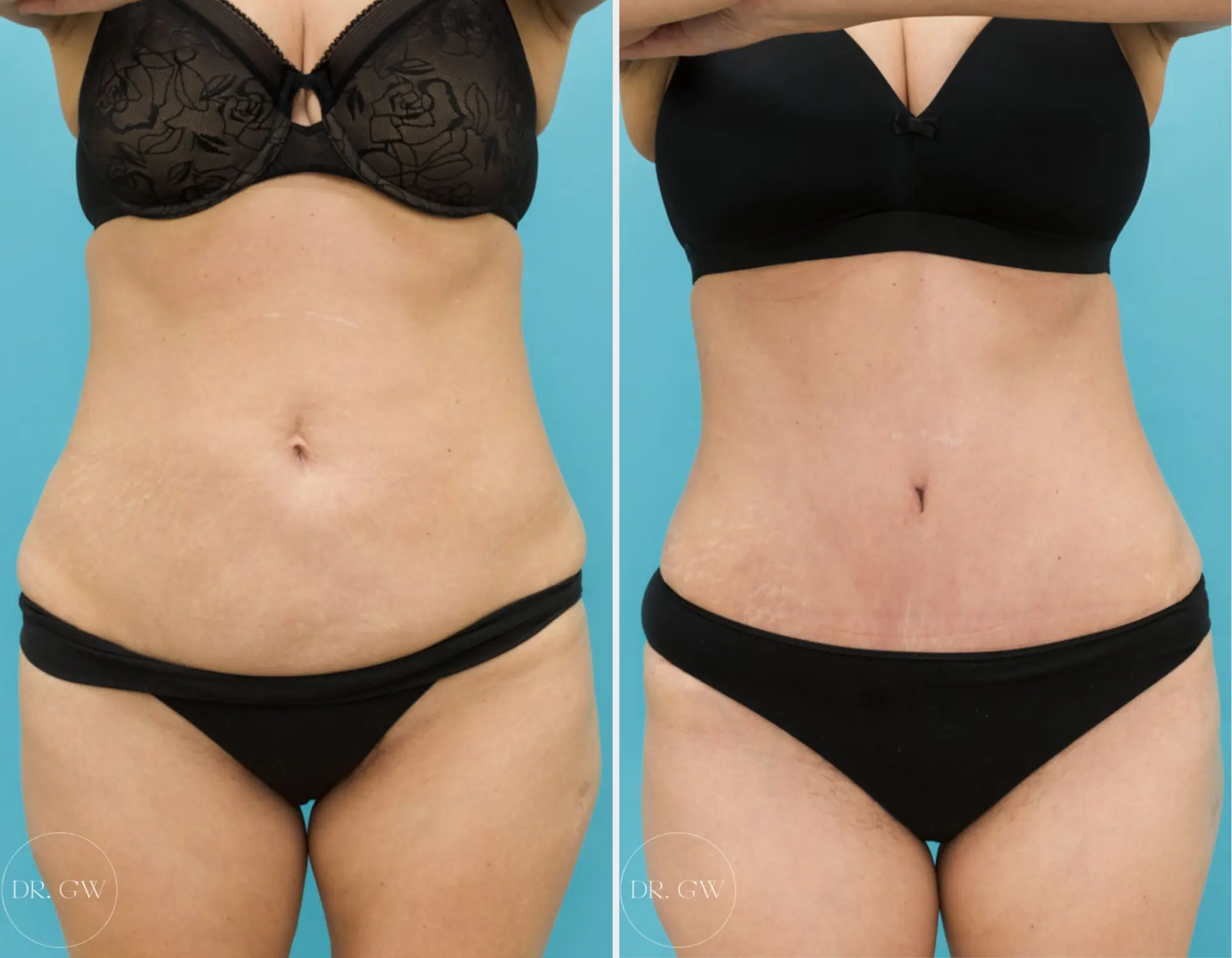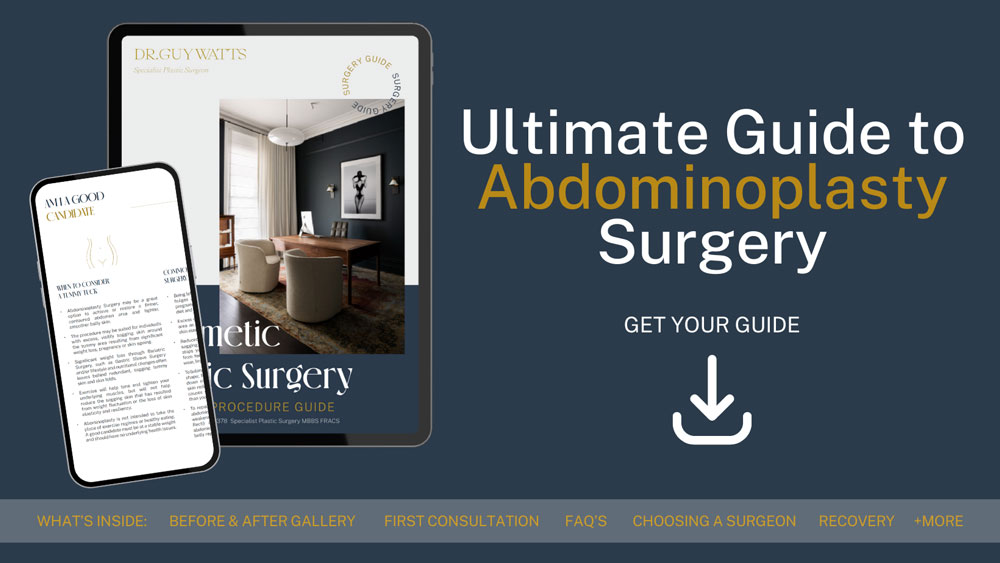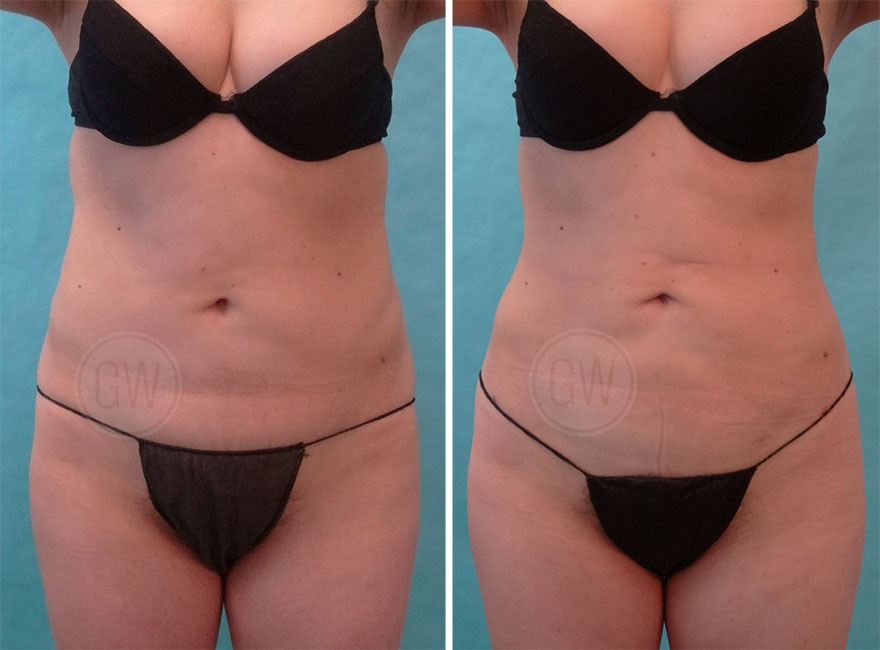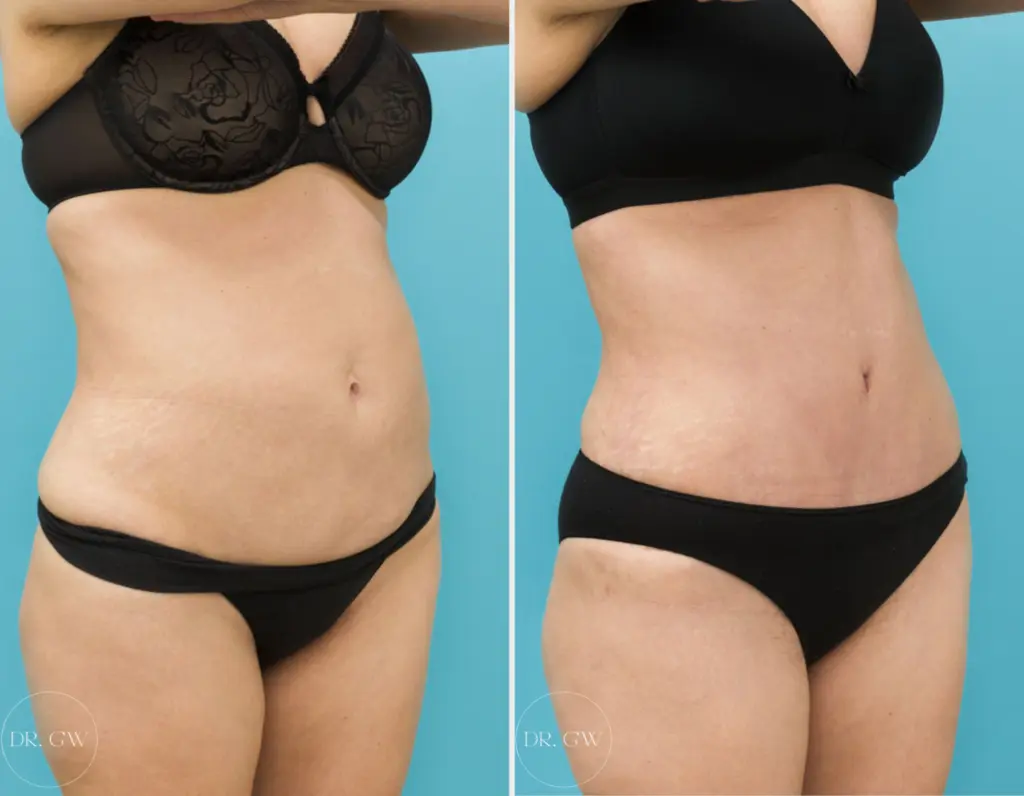
01 Aug How to Get a Smaller Waist
Many individuals find that despite following a healthy diet and consistent exercise regimen, the waistline remains an area of persistent concern. For both women and men, excess fat, skin redundancy, and underlying muscle laxity can all contribute to a broader abdominal appearance that is not responsive to non-surgical interventions.
If you’re exploring how to get a smaller waist and want to understand the options available, Dr. Guy Watts, Specialist Plastic & Reconstructive Surgeon based in Perth, Western Australia, provides clear, evidence-based guidance. This article outlines the surgical pathways available to help address waist contour, including who may benefit, how the procedures work, and what realistic outcomes to expect.
Take our quiz, and find out if you are ready for surgery
Understanding Waist Proportions and Body Contour
Achieving a smaller waist is not simply about reducing body weight. Several anatomic and lifestyle factors contribute to the shape and size of the waist:
- Fat Distribution Patterns: Fat tends to accumulate differently depending on genetic predisposition. Some people are prone to storing fat around the midsection – particularly in the flanks and lower abdomen – despite leading an active lifestyle. These fat deposits can be resistant to both diet and exercise, making surgical intervention the only viable option for targeted contouring.
- Skin Redundancy and Laxity: After pregnancy or major weight loss, the skin around the abdomen can lose its elasticity. Loose or stretched skin, especially if combined with subcutaneous fat, can create a wider waist appearance that won’t improve with non-surgical methods. This is particularly relevant for patients in their 30s to 60s who have undergone significant body changes.
- Muscle Tone and Separation: The rectus abdominis muscles may separate during pregnancy or due to prolonged abdominal distension. This condition – known as rectus diastasis – can lead to a bulging appearance and widened waistline, even in patients with low body fat. Surgical repair is the only definitive method of addressing this structural change.
- Age-Related Soft Tissue Changes: As individuals age, hormonal changes and natural tissue decline can result in increased abdominal fat and reduced collagen production in the skin. These age-related effects can make the waist appear less defined, even in people who maintain a healthy weight and fitness routine.
Understanding these contributing factors helps guide the decision-making process when considering surgical options. A consultation with Dr. Guy Watts in Perth provides patients with a thorough anatomical assessment to determine the most appropriate treatment strategy.
Surgical Procedures to Consider for Waist Reduction
✓ Abdominoplasty and Muscle Tightening
Abdominoplasty is a procedure designed to address multiple concerns around the midsection. It can:
- Remove excess skin and subcutaneous fat: This is especially important after significant weight loss, where the skin may not retract naturally. By excising loose tissue, the waistline appears more defined and streamlined.
- Tighten abdominal muscles: In cases of rectus diastasis, the abdominal wall can be sutured to re-establish a firm central core. This step has both aesthetic and functional benefits, improving core strength and potentially reducing back strain caused by muscle imbalance.
- Reposition the navel: When significant skin is removed, the belly button may be repositioned to maintain anatomical balance. This is a standard part of full abdominoplasty procedures.
- Improve body proportions: By narrowing the waist from the inside (via muscle repair) and outside (via skin and fat removal), the procedure offers a three-dimensional improvement in body contour.
This surgery is typically recommended for individuals who are no longer planning future pregnancies and have reached a stable body weight. Dr. Guy Watts performs abdominoplasty procedures in accredited Perth hospitals, using meticulous techniques to reduce scarring and support optimal healing.
✓ Liposuction for Targeted Fat Removal
Liposuction is a contouring tool used to remove isolated fat deposits that are unresponsive to lifestyle changes. It can:
- Address difficult-to-shift fat in the flanks, hips, and lower back: These areas commonly contribute to a square or undefined waist appearance. By removing fat through small incisions, liposuction enhances the natural taper of the waistline.
- Improve symmetry and proportional balance: In some individuals, fat may accumulate unevenly. Liposuction allows Dr. Watts to create a more harmonious waist contour, working carefully to avoid irregularities.
- Support enhanced definition: When performed on patients with good skin tone and elasticity, liposuction can reveal underlying musculature and improve the silhouette without the need for more extensive skin excision.
- Be customised to male and female anatomies: Men and women store fat differently, and liposuction techniques are adapted accordingly. For example, males may benefit from flank and lower back fat removal, while females often require attention to the lower abdomen and waistline roll.
It is important to note that liposuction is not suitable for patients seeking overall weight loss. It is a precision-based technique that works best for patients with stable body weight and realistic expectations about contouring outcomes.
✓ Combining Procedures for Enhanced Waist Definition
In many patients, a single procedure may not provide optimal results. Dr. Guy Watts often recommends combination approaches for more effective waist refinement, such as:
- Liposuction with Abdominoplasty: When performed together, these procedures can reduce excess fat while also removing loose skin and repairing underlying muscles. This dual approach leads to a smoother contour and more consistent waist definition.
- 360-Degree Contouring: In some cases, liposuction may be extended around the lower back and hips, creating a circumferential improvement in the waist-to-hip ratio. This is particularly helpful for patients who want a balanced result when viewed from both the front and back. Patients considering this comprehensive approach can refer to our guide on Recovery After 360 Liposuction to understand what the healing process typically involves.
- Staged Procedures for Safety: For patients requiring extensive corrections, Dr. Watts may recommend staging procedures to minimise surgical risk and enhance outcomes. Each step is planned strategically to support recovery and maintain results over time.
The planning of combination procedures is highly individualised. At his Perth clinic, Dr. Watts uses detailed imaging and patient-specific analysis to create surgical plans that are both safe and tailored to the patient’s unique body shape and goals.
DOWNLOAD DR WATTS’ GUIDE TO ABDOMINOPLASTY

Realistic Outcomes and Considerations
Surgery can deliver meaningful improvement in waist definition, but it’s vital to approach it with informed expectations. Factors that impact outcomes include:
- Your existing body shape: Each person’s natural proportions set the foundation for what surgery can achieve. Dr. Watts will evaluate whether your goals align with what is surgically possible.
- Tissue elasticity and healing ability: Patients with good skin quality and non-smoking status tend to have better healing capacity and smoother results.
- Post-operative care: Adhering to recovery instructions – such as wearing compression garments, attending follow-up visits, and avoiding strenuous activity – is essential to maximise results and minimise complications.
- Variation in healing responses: Everyone heals differently. Swelling, bruising, and subtle asymmetries may occur during the recovery process and should be discussed with your surgeon during routine post-operative care.
Potential risks include seroma (fluid accumulation), minor infections, delayed wound healing, and numbness or altered sensation around the incision sites. These are generally manageable but require close monitoring.
Dr. Guy Watts ensures all patients receive thorough pre-operative education and post-operative support at his Perth practice, so they feel prepared and supported at every stage of their journey.
Is Surgery the Right Option for You?
Waist-contouring surgery may be appropriate if you meet several of the following criteria:
- You are at a stable weight: Weight fluctuations after surgery can affect the outcome. Patients are advised to maintain a healthy, stable weight for at least 6 months prior to surgery.
- You have completed your family planning: Especially in the case of abdominoplasty, future pregnancies can reverse the benefits of muscle repair and skin tightening.
- You experience discomfort or self-consciousness due to loose skin or fat: Many patients seek surgery not only for appearance but also to improve the fit of clothing, reduce chafing, or address hygiene issues in skin folds.
- You are in good overall health and have no significant medical contraindications: A pre-operative health assessment is essential to determine surgical readiness and minimise the risk of complications.
At Dr. Watts’ Perth clinic, your candidacy will be thoroughly evaluated through a one-on-one consultation, where photographs, measurements, and a complete medical history will be reviewed.
Safety, Recovery, and Professional Care in Perth
Undergoing surgery involves a structured recovery period, and patients should be prepared for the following:
- Initial rest and reduced activity: Most individuals take 10 to 21 days off work, depending on the procedure. Light walking is encouraged soon after surgery to reduce the risk of blood clots, but heavy lifting should be avoided for several weeks.
- Use of compression garments: These garments reduce swelling, support healing tissues, and help shape the surgical area. They are typically worn for 4 to 6 weeks post-operatively.
- Regular follow-up care: Dr. Guy Watts will schedule review appointments to monitor your progress, address any concerns, and ensure that healing is progressing as expected.
- Ongoing support: His Perth-based team remains available to patients throughout their recovery, offering guidance, reassurance, and clinical care as needed.
Patient safety is at the centre of all surgical planning. Dr. Watts adheres to national surgical standards and works exclusively in fully accredited facilities with access to qualified anaesthetists and surgical staff.
FAQs About Surgical Options for a Smaller Waist
Why Choose Dr. Guy Watts for Your Consultation
With years of specialist training and experience in complex body contouring procedures, Dr. Guy Watts offers a professional, evidence-based approach to surgical care. As a Specialist Plastic & Reconstructive Surgeon, he:
- Provides personalised consultations with a strong educational focus.
- Tailors surgical plans based on anatomy, not trends or templates.
- Practices from a discreet, fully accredited facility in Perth.
- Prioritises AHPRA compliance, ensuring ethical communication at all times.
- Maintains a high standard of post-operative care and long-term patient support.
If you’re seeking an honest, medically informed perspective on how to get a smaller waist, Dr. Watts’ practice offers the professionalism and experience required to guide you confidently through the process.
Further Reading
-
- Read more about Dr. Watts’ blog on How Do I Get a Flat Stomach or Flatter Abdomen
About Dr. Guy Watts – MED0001539378
FRACS (Plas) – Specialist Plastic Surgeon In Perth WA
Dr. Guy Watts is a Specialist Plastic Surgeon (AHPRA MED0001539378) with an extensive career that spans across renowned plastic surgery clinics worldwide. His experience has been honed through invaluable experiences at esteemed establishments such as the New York Eye and Ear Infirmary and the renowned Pitanguy Clinic in Brazil.
Having collaborated with the foremost cosmetic plastic surgeons on a global scale, Dr. Watts has chosen to return to Perth after a 17-year journey of intensive training and invaluable professional experience to bring the latest practices and technology in cosmetic plastic surgery to his patients.
Dr. Watts is a Fellow of the Royal Australasian College of Surgeons (FRACS) and a Member of the Australian Society of Plastic Surgeons (ASPS), Australasian Society of Aesthetic Plastic Surgeons (ASAPS) and the International Society of Aesthetic Plastic Surgeons (ISAPS).
Read about the potential Risks and Complications of Surgery
Read the Patient Information and Resources
About CLINISPA
Clinispa is Dr Watts’ bespoke medical clinic performing Cosmetic Aesthetic treatments. At Clinispa, we offer advanced clinical treatments in a luxurious and calming environment, tailored to support your skin’s health and appearance.
Clinispa aesthetic services are performed by Dr Guy Watts’ nursing professionals, who have a passion for and solid understanding of facial aesthetics.
All Clinispa clients are considered individually, with a personalised treatment plan consisting of advanced scientific approaches to cosmetic aesthetics. We incorporate innovative technologies in conjunction with superiorly formulated skin care.
For more information about the full range of Clinispa Aesthetic of Cosmetic Treatments visit the Clinispa website










Sorry, the comment form is closed at this time.